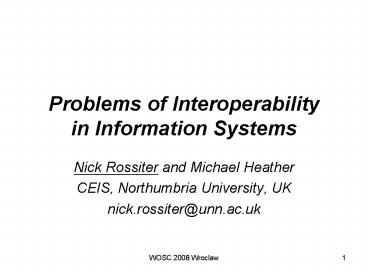Problems of Interoperability in Information Systems PowerPoint PPT Presentation
1 / 21
Title: Problems of Interoperability in Information Systems
1
Problems of Interoperabilityin Information
Systems
- Nick Rossiter and Michael Heather
- CEIS, Northumbria University, UK
- nick.rossiter_at_unn.ac.uk
2
Four Challenges
- Enterprise Interoperability
- Knowledge-oriented Collaboration
- Web Technologies
- Interoperability Service Utility
- Need dynamic connections
3
What is Underlying Logic?
- Not set theory
- OK for closed local systems
- But falls foul of Gödel as higher-order
operations needed - Neither complete nor decidable outside FOPC
- CWA is not realistic
- But experimental verification is valuable
- Not pure category theory
- Axiomatic
- So also falls foul of Gödel
4
Process Logic
- Strong candidate
- Long pedigree
- Heraclites
- Whitehead
- Category theory
- Cartesian closed categories
5
Uses of Category Theory
- Cartesian closed categories (CCC, naturality)?
- Systems theory with Heyting logic (open systems)?
- Topos (SoS)?
- Monad (transaction logic, process)?
- Adjointness (relationships)?
- 2-categories (vertical horizontal composition)?
- Higher-order logic in CCC
- Without axioms and reliance on number
- Gödel free in connecting systems in our view
- For good practice, avoid categorification
6
Twin-track Approach
- Two subsystems
- 1. Data Structures and Rules
- 3-level architecture
- In terms of mappings A ?B ? C ?D
- With dual D ? C ? B ? A
- 2. Behaviour
- 3-level architecture
- In terms of cycles F A? B G B? A
- GF 3 times
- FG 3 times
7
Example of Adjointness
- If conditions hold, then we can write F G
- The adjunction is represented by a 4-tuple
- ltF,G,?, egt
- ? and e are unit and counit respectively
- L, R are categories F, G are functors
F
L
R
G
8
Data Structures and Rules
Organise
Policy
Instantiate
Name
Meta
MetaMeta
A is category for Concepts B is category for
Constructs C is category for Schema D is category
for Data
Adjunctions compose naturally F-G is one of 6
adjunctions (if they hold)
9
Principles
- Have pairs of abstractions
- Each level is defined by level above
- Adjunctions permit relationships less than
equivalence between the levels - Having more than three levels of abstraction does
not achieve greater precision - Can be viewed as multi-level type subsystem
10
Six Possible Adjunctions
- F G
11
Adjunctions in More DetailSimple Pairs
12
Adjunctions in More DetailDoubles
13
Adjunctions in More DetailTriples
14
Desired Properties
- If all adjunctions hold
- Have clearly-defined multi-level type subsystem
- Can relate one subsystem to another by
- Natural transformation
- Maps between functors
- Provides interoperability between subsystems for
- Data structures and rules
15
Natural Transformation
F
L
R
a
F'
a is natural transformation comparing F and F'
16
Behaviour/AnticipationMonad/Comonad
- Define subsystem
- Handle transactions
- ACID properties
- Atomicity, Consistency, Isolation, Durability
- Have 3 cycles
- 1. make changes
- 2. review changes
- 3. holistic check that all is well
- Example with Bank ATM
- 1. debit account
- 2. check funds available
- 3. holistic check that all changes recorded safely
17
Monad
- Construction for transactions is the Monad
- Monad is a triple ltT, ?, µgt
- T is an endofunctor (functor with same source and
target) - e.g. GF A ? B ? A
- ? is unit of adjunction e.g. 1L? GF(L)
- Compares initial value for object L with value
for L after one cycle - µ is multiplication T2 ? T
- comparing result from 2nd cycle with 1st
- e.g. GFGF ? GF
- Full details of definition involve T3 (GFGFGF)
18
Comonad
- Monad gives left-hand-perspective (L)
- Comonad gives right-hand perspective (R)
- Comonad is a triple ltS, e, dgt
- S is FG
- e.g. B ? A ? B
- e is counit of adjunction e.g. FG(R) ? 1R
- d is comultiplication T ? T2
- Anticipation looking forward
19
(No Transcript)
20
System Viewpoint for Interoperability
- Have a system formed from 2 subsystems
- For data structures/rules
- 3 levels of mapping as functors between
categories - Each mapping represents a level-pair of
abstractions - For behaviour
- 3 cycles as a monad/comonad structure
- Interoperability
- Comparing one system with another by natural
transformations or higher-order categories - Recent work on Security by PhD student Dimitris
Sisiaridis with category theory produces the
system unification
21
Possible Way Forward
- Not for everybody to learn category theory!
- Development of tool
- Assist with interoperability
- Based on process category theory
- Graphical
- Haskell is a candidate
- Facilities include monads

